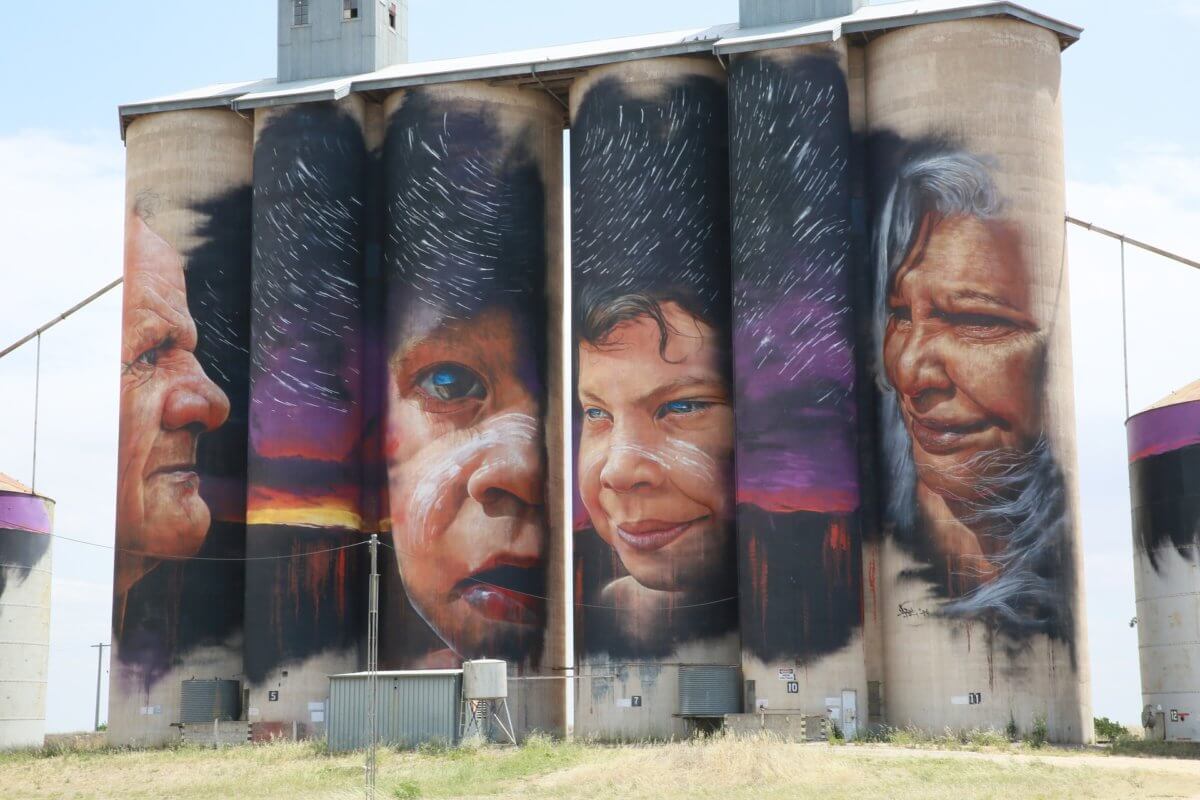In Northam, the sunset matches the land. Layers of red, pink and brown like an endless gradient seep in to the scrubby horizon. Silhouetted against the darkening sky is the tiny town’s biggest art installation, its shades of green and blue almost garish in this brush-soft landscape. The site of this art? Not, as you might expect, another of Australia’s giant objects. Instead, the 6,500-person town 100km north-east of Perth hosted artists Phlegm and HENSE in 2015, who were tasked with painting its 36m tall silos. Three and a half years later, a unique collaboration has seen six different silo artworks take shape across Western Australia’s south, inspiring many more in other states.
Tower silos are tall cylindrical structures for storing bulk materials – in this case, grain. They are used by farmers or country towns to collect grain, enabling it to be stored and protected until it is transported for export or processing. Already significant landmarks in many small towns, the idea to use them as canvases for giant works of art which could be used to bring togetherness and tourism to small and struggling communities was inspired.
WA’s six installations form the Public Silo Trail, which began as a collaboration between a grain grower cooperative (CBH Group) and FORM, an independent cultural organisation. Six towns and eight artists were carefully selected for the project, which was seen as an opportunity to create an open-air cultural tourism opportunity in frequently overlooked regional areas. While both the surfaces being painted on (steel or concrete? porous or smooth?) and the pieces themselves were vastly different, FORM aimed for each one to act as a representation of the local community.
For many struggling rural towns, these silos are the promise of economic rejuvenation. Rochester, in Victoria’s north, pinned its hope on Jimmy DVate and the kingfisher he painted on a Grain Corp silo near the Northern Highway. Two weeks from completion, the mural – which depicts the bright blue and yellow bird on the banks of a river, feeding on a local fish – had already made the town “almost chaotic” with weekend traffic. It wasn’t only locals who stood at the foot of the silo to watch it take shape. Many tourists and residents of regional towns stopped by to have lunch and see the mural, bringing hope for local businesses.
The owner of Goorombat’s Railway Hotel says that the barking owl mural she can see from her window – also by Jimmy DVate – has brought life back to the pub. Formerly spare weekday lunches have seen as many as 30 meals served, and customers have had to be turned away on weekends. In Brim, where the first mural in regional Victoria took shape, tourists have continued to stop. As many as 20 vans are still seen overnight at the caravan park – with more during Christmas and Easter. Thousands more stopped in the small town of Coonalpyn, in South Australia’s south-east, to watch a mural of a local schoolgirl take form in 2017. The newly opened Coonalpyn Silo Café has benefited significantly from the business, and the District Authority has had to institute a traffic management plan to deal with the number of trucks pulling over.
Innovative solutions have been harnessed to help the towns maximise their profits, such as solar panels to illuminate the silos at night. DVate sees these collaborations as reflective of a greater aim to the murals. To him, they are more than a money-making opportunity, but a way to increase the wellbeing of towns and bring them together. With mental health issues a severe problem in rural Australia, and often stemming from the isolation felt by those in farm environments, community togetherness is an important aim. Guido Van Helsen, the artist of the Coonalpyn schoolgirl, is fondly considered a “local” and has been taken out for activities from drinking to sheep-shearing with the farming populations he has painted for.
The presence and importance of silo art is increasingly being recognised around Australia. Now, a new series of four Australia Post $1 stamps are set to display the murals at Brim in Victoria, Ravensthorpe in Western Australia, Fallon in Queensland and Weethalle in NSW. Australia Post’s philatelic manager Michael Zsolt sees silo art as a symbol of rural communities, and the environment, history and industries at their heart.
The Public Silo Trail officially launches this month, and FORM will be installing interpretive signage and starting a website with pictures and artist information. Hope for the rejuvenation of these rural communities is sorely needed, and silo art has plenty to give.
We acknowledge the Ngunnawal and Ngambri people, who are the Traditional Custodians of the land on which Woroni, Woroni Radio and Woroni TV are created, edited, published, printed and distributed. We pay our respects to Elders past and present. We acknowledge that the name Woroni was taken from the Wadi Wadi Nation without permission, and we are striving to do better for future reconciliation.
